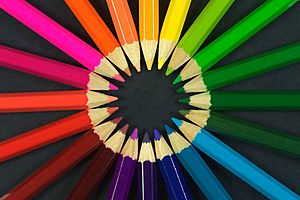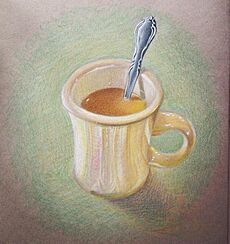Colored pencil facts for kids
A colored pencil is a drawing tool with a narrow, colorful core inside a wooden case. Unlike regular pencils made of graphite, colored pencils have cores made from wax or oil. These cores contain tiny bits of pigment (color), plus other ingredients and binding agents that hold them together. You can also find special types like water-soluble (watercolor) pencils and pastel pencils. Some even have colored cores for mechanical pencils!
Colored pencils come in many different qualities, from ones for students to those for professional artists. The quality depends on things like how much color pigment is in the core, how well the colors resist fading in sunlight (called lightfastness), how strong the pencil is, and how soft the core feels. Higher quality pencils usually cost more. Both wax/oil-based and water-soluble pencils can be high quality. Artists often keep their colored pencils in pencil cases to protect them.
For a long time, the art world didn't see colored pencils as seriously as other art tools. But now, with new drawing methods, better pencils that don't fade, and art groups supporting them, colored pencils are becoming more popular. They are also often cheaper, cleaner, and easier to use than many other art supplies.
Contents
The History of Colored Pencils
People have used wax-based art materials, like crayons, for a very long time. Ancient Greeks used them, and a Roman writer named Pliny the Elder wrote about them. Artists liked wax materials because they lasted a long time, had bright colors, and created unique effects.
Even though colored pencils were used for "checking and marking" things for many years, pencils specifically for artists didn't appear until the early 1900s. Some of the first companies to make artist-quality colored pencils were Faber-Castell in 1908 and Caran d’Ache in 1924. Later, Berol Prismacolor started making them in 1938. Other well-known brands today include Bruynzeel-Sakura, Cretacolor, Derwent, Koh-i-Noor Hardtmuth, Mitsubishi (uni-ball), Schwan-Stabilo, and Staedtler.
Different Kinds of Colored Pencils
There are several types of colored pencils, each designed for different uses, from art projects to everyday tasks.
Artist-Grade Pencils: What Makes Them Special?
Artist-grade pencils are made with lots of high-quality colors. They are tested to see how well their colors resist fading from UV rays (sunlight). This is called lightfastness. These pencils are also very durable, resist breaking, and often don't smudge with water. Artist-grade pencils come in the widest range of colors, often 72 or even 120 colors or more. You can usually buy them one by one, not just in sets.
Student-Grade Pencils: Good for Beginners
Many companies that make artist-grade pencils also make student-grade ones. These pencils usually don't have a lightfastness rating. The way their cores are made and the amount of color pigment can be different, even from the same company. Student-grade pencils have fewer high-quality pigments and a smaller range of colors, often just 24 or 36.
However, student-grade pencils have their own benefits. Some companies make erasable colored pencils, which are great for beginners to try out. They also cost much less than artist-grade pencils, making them a good choice for kids and students.
Watercolor Pencils: Add Water for New Effects
Watercolor pencils are also known as water-soluble pencils. They are very flexible art tools. You can use them dry, just like regular colored pencils. Or, you can add water to create a watercolor effect. To do this, you first draw with the dry pencil. Then, you use a damp paintbrush to spread and mix the colors. This technique can also blend colors together. Many artists use both dry and wet methods in the same artwork. Artist-grade watercolor pencils often come in sets of 60 or 72 colors, and some sets have up to 120 colors.
Oil-Based Pencils: Smooth and Detailed
Oil-based pencils use an oil-based binder to hold the pigment. This makes them feel smoother when you draw and helps them last longer. They are great for drawing fine details and don't create as much "wax bloom" (a cloudy film) as wax-based pencils. This type of pencil blends and layers colors very well, helping artists create smooth color changes and deep, rich artwork. Oil-based pencils are known for their bright colors and work well on many different surfaces. Professionals often choose them for detailed work that needs to last.
Pastel Pencils: Like Hard Pastels in a Pencil
Pastel pencils are similar to hard pastels. You can use them by themselves or mix them with other art materials. They can be used dry, wet, or blended. Many artists use them for quick sketches because regular graphite pencils don't mix well with pastels. You can also sharpen them to a very fine point to add tiny details to pastel drawings.
Cool Techniques for Colored Pencils
Colored pencils can be used with other drawing tools. When used alone, artists often use two main techniques:
- Layering is usually the first step in a colored pencil drawing. You build up colors slowly by adding many thin layers of different colors. Layered drawings often show the texture of the paper and look a bit grainy or fuzzy.
- Burnishing is a blending trick. You press down firmly with a colorless blending tool or a light-colored pencil over an area you've already layered. This makes the colors look shiny and smooth, pushing them deep into the paper's texture.
- Roughening creates cool textures. You place a rough piece of paper under your drawing paper. Then, you rub the drawing paper with a smooth object to make dents. When you draw over these dents with colored pencil, the design will stand out.
- Scoring patterns helps create highlights. You use tracing paper or clear paper and a sharp pen. Place the paper over the area you want to impress. Then, press moderately to draw your desired line or pattern.
- Fusing colors means physically blending the colored pencil pigments. You can use special solvents, a colorless blender, or both. This technique helps colors mix easily into a single, smooth color.
See Also
- Blue pencil (editing)
- List of art media
- List of pen types, brands and companies




